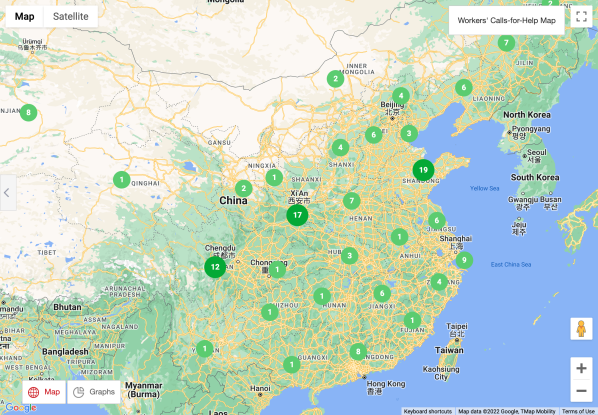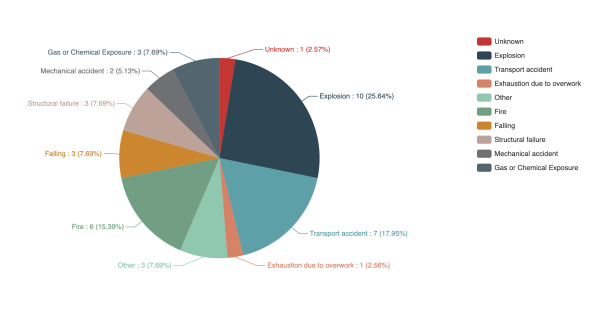
Photograph: NG-Spacetime / Shutterstock.com
Based on the data we collected in June 2022 on worker strikes and protests, labour disputes, and workplace accidents, China Labour Bulletin has analysed recent trends below. Among other observations, we found a higher than usual proportion of strikes and protests in the construction sector, with several incidents concentrated in Xi’an. If this email was forwarded to you, feel free to subscribe here.
But first, don’t miss the content we’ve published on our website recently:
- Construction worker protests increase with property market instability. Construction worker protests accounted for over 50 percent of all incidents recorded on China Labour Bulletin's Strike Map in the first half of 2022, matching levels seen only in 2018. Normally, between 30 to 40 percent of the incidents sampled by CLB in any given month are from this sector. Protests over unpaid wages in the construction sector continue to be the most prevalent and desperate form of worker unrest in China - and are more frequently met with violence - despite government pledges to put an end to the endemic problem.
- June 2022 labour news roundup: Restaurant closures leave millions of workers without jobs. In our roundup of news stories making headlines in China, we cover the following topics: Catering industry stalls under high operating costs; delivery drivers detained for violating Shanghai’s pandemic prevention regulations; construction companies transfer Covid-positive workers to unhygienic facilities; all levels of government urged to hire new graduates; physical examinations lead to insidious employment discrimination.
- Migrant worker unions help Hong Kong sanitation workers win back wages deducted for isolating with Covid-19. A Thai migrant sanitation worker under the pseudonym Waan caught Covid-19 at the start of Hong Kong’s deadly fifth wave of the pandemic. However, amendments to the Employment Ordinance guaranteeing workers’ sick leave for Covid-19 isolation, quarantine, and treatment was not passed until June 2022 and is not retroactive. In the meantime, migrant worker unions helped workers, including Waan, negotiate with employers over sick pay.
- Shanghai blast is one of many heavy industry accidents in China’s June Work Safety Month. A massive explosion at a state-owned petrochemical plant in Shanghai on 18 June is the latest in a string of deadly blasts last month. Our map logged six accidents in May 2022, a record high for CLB’s eight years of Accident Map data. With June designated as China’s workplace safety month, the cycle of campaigns and empty pledges to improve conditions have done little to actually protect the safety of workers.
- Hong Kong and mainland elder care workers in fifth pandemic wave face common industry challenges. In this investigation, based on CLB’s two original reports written in Chinese, we explore the working conditions for workers in residential care homes for the elderly in Hong Kong, the experiences of local workers versus non-local workers, and potential solutions to the ongoing public health and labour challenge of staff shortage under the backdrop of the pandemic. We found that although bringing in non-local workers can be part of the solution, low staffing levels are largely the result of poor working conditions. Improving labour conditions and fostering more dignity for both patients and workers is a more sustainable way to alleviate the labour shortage and is in the interest of local and non-local workers alike.
- Pandemic prevention measures lead to variety of worker protests. Our Strike Map recorded 14 worker protests related to Covid-19 since March, eight of which occurred in hard-hit Shanghai, which has been slowly exiting a three-month city-wide lockdown. This is just the tip of the iceberg, as we estimate to only collect about 5-10 percent of incidents. Poor working conditions under strict lockdown measures led to protests not only by doctors, nurses, and white-clad pandemic workers, but also factory workers, taxi drivers and others.
- High unemployment rate indicates bleak job prospects for university graduates. China’s urban unemployment rate rose to 6.1 percent in May 2022, almost reaching the same rate recorded during the initial outbreak of the pandemic, according to data released by the National Bureau of Statistics. The unemployment rate of those 16-24 years old is particularly high, reaching 18.2 percent in April, the highest level in history and almost double the next highest rate recorded, in April 2019 (9.9 percent). In this report, we examine state responses to youth unemployment and labour implications for today’s young people in the near and long term.
- Book Review: The Urbanization of People by Eli Friedman. Eli Friedman’s latest research provides unparalleled insight into Beijing’s migrant worker population through the study of a fundamental site in their and their families’ lives: the migrant elementary school. Friedman’s study takes a whole-person and intergenerational approach to the question of how China’s national policies and access to its capital city’s public services are designed to discriminate and exclude this dynamic population that the city simultaneously relies upon for its informal labour. CLB highly recommends this book.



